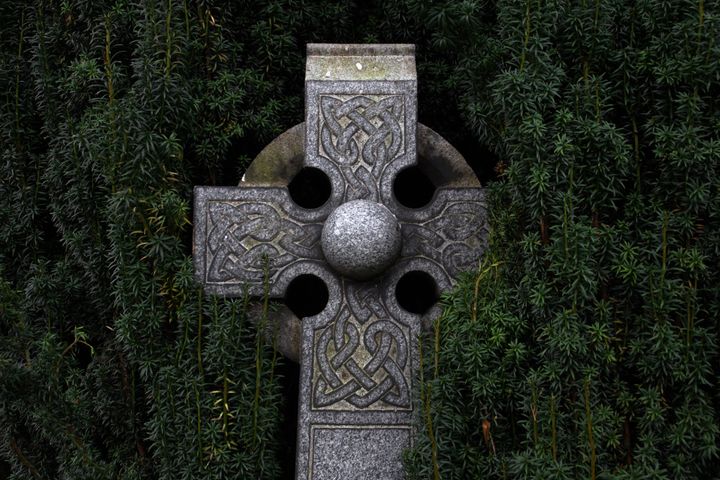
How Illness Alters Our View of Time and Space
This past weekend I attended a Celtic Spirituality Retreat at the Center for Prayer and Pilgrimage at the Washington National Cathedral. As November 1 is the beginning of the Celtic year, we reflected on the change of seasons. Halloween and the following day, All Saint’s Day, mark a “thin time” in the calendar.
A thin time is a time when the seen and unseen come together, when the sacred and ineffable converge with human and earth. Hence, on November 1, as a thin time, we remember and feel close to those who have died. Other times of the year that are deemed thin include the equinoxes and solstices as well as the transition into the other Celtic seasons, which are:
- November 1 Samhain
- February 1 Imbolc
- May 1 Beltane
- August 1 Lughnasadh
Caitlín Matthews elaborates on this thin time:
Samhain means “the summer’s end.” In the early days, this festival heralded a period with the gates of síd (SHEE), the faery gates of the otherworld, were open and when the ancestors were nearer to the otherworld than at any other time. (1)
There are also thin places - places that evoke a sense of wonder and of joy and unconditional love. Peter Gomes, a professor at Harvard’s Divinity School described thin places this way:
There is in Celtic mythology the notion of 'thin places' in the universe where the visible and the invisible world come into their closest proximity. To seek such places is the vocation of the wise and the good — and for those that find them, the clearest communication between the temporal and eternal. Mountains and rivers are particularly favored as thin places marking invariably as they do, the horizontal and perpendicular frontiers. But perhaps the ultimate of these thin places in the human condition are the experiences people are likely to have as they encounter suffering, joy, and mystery. (2)
Some thin places are famous. Shrines such as the Shrine of Santiago de Compostela or Shrine of Our Lady of Walsingham are old and well known. White Sands National Monument in New Mexico or Joshua Tree in California are two other examples. For me, close by in DC, Great Falls is a thin place I go to feel connected not only to nature but to the wonder of creation.
There are also thin spaces - a moment in time or an event in our lives that pushes us into a closer sense of sacred wonder. Illness is just such an event. So is a period of grieving. The birth of a child is another thin space of time.
When we get sick or suffer, why do we become more spiritual? A facile answer I’ve sometimes heard suggests that ill people use religion as a crutch, because they need “answers” and a “reason.” Religion is deemed and condescended to as a false comfort, an opioid of the masses. (Though according to new reports, increasingly, opioids are the opioids of the masses.) For me, religion does not provide answers; faith requires us to abide the questions without answers.
Likewise, one might think illness is karma for some injustice earlier in life or in an earlier life. That’s not right either.
Rather three factors are at work ::
Humility
When you’re no longer able to rely on your body, when you have mercurial symptoms affecting your life, when you “function” with an illness that can’t be treated well or cured, you have a greater sense than most of the lack of control integral to all lives. Any one can have their life changed in an instant; those who live with illness live closer to that reality in ways big and small every instant of every day. We have a greater sense of life’s fragility and of our own peril. Illness is a face-plant into vulnerability. Our bodies embody the unseen and the powerful. And when sickness brings yet another bothersome ailment (“Not again!”), wonder and mystery become regular companions. This humility pushes us to a real sense of all we don’t know.
Value
When you are too sick to function, feeling valued, feeling of value, presents special difficulties. Our culture is so orientated toward revering those who do, that those who don’t end up feeling useless. If we don’t produce, we are worthless. If we do not contribute (to our families, to our communities, to our income), why do we exist?
After our names, we are most often asked what we do. When sickness forces you to do only the bare necessities of life, the answer to that question is reduced to: “I eat and I sleep.” (I sometimes answer with that in a tone that clouds whether or not I am joking.)
When Moses asked God for a name, God replied “I am that I am,” not “I am what I do.” Meditation requires us to be still, not do. “Amen” means “so be it,” not “so do it.” Integral to the name of our species, we respect human beings, not human doers. The common emphasis is on being not doing. That import on simply being colors our existence much more vividly. Those who are ill don’t get their worth caught up in their possessions or their status or their income. Or what they do. They can’t afford to.
Clarity
One of my yoga teachers would look at someone and observe they were the walking dead. She was not referring to zombies. She meant that the person was not awake and aware and that they live in a muted, habitual world. Getting sick is a slap in the face that jolts you and alters the landscape of your world so that everything is more vivid and evident.
A painting technique, developed during the Renaissance, called chiaroscuro captures this changed view. Using strong contrasts of light and dark, features are pronounced and magnified. Living with illness, likewise, casts intense tones of light and shadow. Unlike the walking dead, the features of our lives are put into sharp relief. That we love, we love more. That which annoys, irritates us more. That which we abhor, we hate. Illness itself pushes us to a thin space where joy and suffering are both vibrant and magnified.
Where have you encountered thin spaces, places or times? I have in a cold crypt in Lastingham, a small village in northeast England, and again in a moonlit meadow that opened before me and surprised me during a nighttime cross-country ski run. I have in a classical concert and in reading poetry, especially the Four Quartets by T.S. Elliot. And sometimes, if I’m lucky, I encounter thinning when I meditate or lie in corpse pose at the end of a yoga class.
The beauty and wonder of this thinness nourishes us - whether we are sick or not. We, in the seen and temporal world, can know and feel the unseen and eternal. These limitless and liminal moments are to be sought and treasured by all.
Special thanks to Dr. Terri Lynn Simpson who led the retreat this past weekend as well as a terrific one I also attended last February. Her knowledge and insight created a thin time and place for those who attended. Click here to learn more about her and her retreats.
Cassandra Marcella Metzger, JD, MA, RYT is the creator and founder of the newly, launched Wellspring Stones ― the online oasis for those living with illness. After she struggled to find accessible and applicable help on how to live well with illness, she decided to prove that living well while ill wasn’t an oxymoron. She is passionate about creating space for change so that those living with illness can feel alive, dynamic, valued, engaged and connected. She advocates to give voice to the shame and suffering of those who are chronically ill and struggling without help, without resources and without attention. Join the movement to make invisible illness seen and find out more here. To read her other Huffington Post posts click on her profile above.
(1) Matthews, Caitlín. The Celtic Spirit : Daily Meditations for the Turning of the Year. New York: HarperCollins, 1998, p. 4.
(2) Gomes, Peter J. The Good Book: Reading the Bible with Mind and Heart. New York: HarperOne, 2002.
